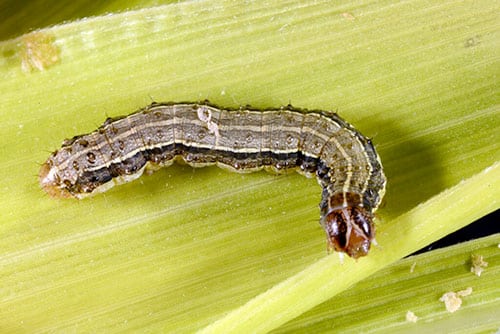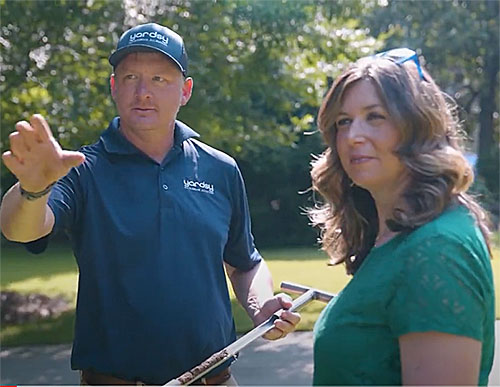As the fall season approaches, one of the seasonal challenges that can threaten your outdoor haven is the invasion of fall armyworms. Armyworms are known for their insatiable appetite. They can quickly cause significant damage as they march across grass and other vegetation in large groups. It takes quick action to prevent an armyworm invasion from ruining your lawn. Prompt treatment is required within 24 hours in most cases.
Fall armyworms are not actually worms but caterpillars (larvae) of a moth that arrive in Georgia and neighboring states almost every year. Moving from Florida into our area takes multiple generations of moths, so armyworms are typically seen here in late summer and early fall.
Let’s go over what you need to know about armyworms, including their identification and life cycle, the damage they can inflict on your yard, and the strategies you can use to protect your lawn and garden.
Identifying Fall Armyworms

Fall armyworms are the larvae of a small, brownish-gray moth that migrates north from Florida each spring and summer. They are particularly attracted to young, succulent grass, making newly sodded lawns common targets. Armyworms are named for their army-like movement across vegetation, consuming everything in their path.
Fall armyworm larvae come in shades from light green to almost black. They have several stripes along their bodies. A key feature to spot is the light-colored, inverted Y-shape on their head. This unique “Y” mark sets the fall armyworm apart from other species.
Understanding The Life Cycle
To effectively combat fall armyworm infestations, it’s important to understand their life cycle, which consists of several stages:
Egg Stage: In the first stage of their life cycle, armyworm moths lay small, white eggs in large clusters on various surfaces at night. The eggs darken as they mature. You can find these egg clusters in various places, including the undersides of tree leaves, fences, bleachers, water coolers, and even light poles.
Larval Stage: After a few days, the eggs hatch into caterpillars (larvae), which feed and grow for about 2-3 weeks. Armyworms are most active and cause lawn and garden damage during this stage, feeding throughout the day, especially in the early morning and late evenings.
Pupal Stage: Once fully grown, the larvae burrow about 1-2 inches deep into the soil and form the pupal stage. This stage lasts 11 to 13 days when the pupae are smooth and reddish-brown.
Adult Stage: The cycle completes when adults emerge from the pupae to mate and lay eggs, living for about two weeks. The adult moths that lay the eggs are brown and have a distinctive white spot on each wing. These moths are nocturnal and can often be seen flying around outdoor lights during the evening.
When Are Fall Armyworms Active?

Fall armyworms are most active during the warm months, typically from late spring through early fall. Their activity depends on the local climate and temperature conditions, so it’s essential to remain vigilant throughout the warm seasons. Some years, there are significant infestations, while in other years, there may be no issues at all.
You’ll likely see damage from these pests from August to October when their numbers are highest. Dry conditions favor fall armyworms because their natural predators are less active during droughts. You can find these pests until the first hard frost, so the risk of damage decreases as the weather cools down.
Recognize The Signs Of Fall Armyworms
Fall armyworms are known for their insatiable appetite, and they can cause significant damage to your lawn, garden, and even certain crops. Here are some common signs of a fall armyworm infestation:
- Brown Patches: Fall armyworms can quickly strip your grass of its green foliage, leaving behind unsightly brown patches on your lawn.
- Unusual Lawn Stripes: They have distinctive irregular feeding patterns, often resembling stripes across your lawn or garden.
- Visible Caterpillars: Sometimes, you will see the caterpillars, which can be green, brown, or black, with prominent stripes along their bodies.
- Increased Bird Activity: Birds are natural predators of fall armyworms, so increased bird activity in your outdoor spaces may indicate an infestation.
How To Deal With Fall Armyworms

Now that you’re familiar with fall armyworms and the damage they can cause let’s explore effective strategies to deal with them and protect your lawn and garden:
- Early Detection:
- Regularly inspect your yard for signs of armyworms, especially if any areas have recently turned brown.
- Look for the adult moth form of the armyworm, indicating nearby caterpillar activity.
- Consult a Professional
- If unsure about the infestation’s extent or treatment, seek advice from a lawn care professional.
- Don’t wait – armyworms can devastate your lawn in as little as 24 hours!
- DIY Insecticide Treatment:
- Apply insecticides when you find three or more armyworms per square foot.
- Consider using insecticides specifically formulated for fall armyworm control.
- Always follow label instructions for safe and effective use.
- DIY Insecticide Application Tips:
- Treat in the early morning or late afternoon when caterpillars are most active.
- Mow before treatment and avoid mowing for three days after.
- Repeat treatments may be required to break the armyworm life cycle.
- Reseed Affected Areas:
- If damage is extensive, reseed or replant areas after controlling the infestation.
Armed with knowledge about identifying and eradicating fall armyworms, you can protect your outdoor spaces from their destructive feeding habits. Regular monitoring, early detection, and prompt infestation management are crucial to minimizing the damage caused by these pests. By taking these steps, you can ensure that your outdoor haven remains a lush and vibrant paradise throughout the warm months, even in the face of a potential fall armyworm invasion.
Yardsy: Your Solution to Fall Armyworm Infestations
Early detection and treatment are crucial in the battle against fall armyworms, and Yardsy is here to help. Our team of skilled and friendly lawn care experts is dedicated to keeping your outdoor spaces pristine and enjoyable. We pride ourselves on exceptional customer service, distinguishing us from other lawn care service providers. Learn more about safeguarding your lawn and discover how the Yardsy difference will keep your yard beautiful year round.
